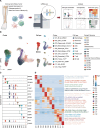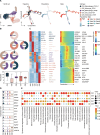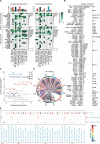Single-cell transcriptomics reveals metabolic remodeling and functional specialization in the immune microenvironment of bone tumors
- PMID: 40380260
- PMCID: PMC12084933
- DOI: 10.1186/s12967-025-06346-0
Single-cell transcriptomics reveals metabolic remodeling and functional specialization in the immune microenvironment of bone tumors
Abstract
Objective: To investigate the metabolic remodeling and functional specialization of immune cells within the tumor microenvironment (TME) of bone tumors, including Ewing's sarcoma, osteosarcoma, and giant cell tumor of bone, through high-resolution single-cell RNA sequencing (scRNA-seq) analysis.
Methods: Immune cells were isolated from 13 bone tumor samples and profiled via scRNA-seq to delineate cellular compositions, metabolic adaptations, and intercellular communication networks. Differential gene expression analysis, metabolic pathway enrichment, and pseudotime trajectory inference were employed to characterize functional states and differentiation processes of immune cell subsets.
Results: We identified 12 major immune cell clusters with distinct functional and metabolic characteristics. Naïve T cells exhibited amino acid metabolism-dependent activation potential, whereas NK cells relied on lipid metabolism and the TCA cycle for cytotoxic activity. Macrophage subsets demonstrated functional divergence: C06 macrophages adopted lipid metabolism to facilitate immunosuppression and tissue repair, while C04 macrophages displayed pro-inflammatory characteristics associated with complement activation. Intercellular signaling analysis revealed FN1 as a central regulator of immune coordination, governing cell adhesion, migration, and homeostasis within the TME.
Conclusion: This study provides novel insights into the metabolic and functional plasticity of immune cells in bone tumor TMEs, underscoring the critical role of metabolic remodeling in immune regulation. Our findings highlight potential therapeutic targets for modulating immune cell function and offering new avenues to improve treatment outcomes for patients with bone tumors.
Keywords: Bone tumors; Immune microenvironment; Metabolic remodeling; ScRNA-seq.
© 2025. The Author(s).
Conflict of interest statement
Declarations. Ethics approval and consent to participate: Not applicable. Consent for publication: The authors have consent for publication. Competing interests: No potential conflict of interest was reported by the authors.
Figures





References
-
- Nik-Ahd M, Agrawal AK, Zimel M. Diagnosis and management of pediatric primary bone tumors in the emergency department. Pediatr Emerg Med Pract. 2021;18(7):1–20. - PubMed
-
- Folkert IW, et al. Primary bone tumors: challenges and opportunities for CAR-T therapies. J Bone Miner Res. 2019;34(10):1780–8. - PubMed
-
- Ogilvie CM, Cheng EY. What’s new in primary bone tumors. J Bone Joint Surg Am. 2016;98(24):2109–13. - PubMed
MeSH terms
LinkOut - more resources
Full Text Sources
Medical
Miscellaneous

